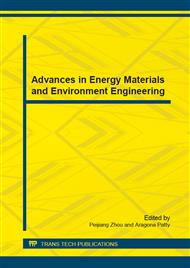p.542
p.549
p.553
p.559
p.567
p.572
p.576
p.583
p.587
Study of Red Mud as Compound Sulfur-Fixing Agent
Abstract:
The research has revealed the problem of sulfur dioxide emissions during the coal combustion. Combustion experiments were made for Shanxi coal at 1000oC. Red mud, carbide and shell powder were chosen as the primary sulfur-fixing agent. Through the experiment, the best ratio of Ca/S is 2.0 at 1000oC. When the ratio of red mud, carbide and shell powder were 50%, 15% and 35%, the maximum sulfur-fixing efficiency was 76.05%. Orthogonal experimental results showed that the best additive formula was 9% of Fe2O3, 5% of Na2CO3, 5% of ZnO. The maximum sulfur-fixing efficiency reached 89.23%. In addition, it was made thermogravimetric analysis of coal with different additives. By contrast, samples with sulfur-fixing agent generated two-stage combustion significantly, ignition point increased. The amount of coal residues with sulfur-fixing agent and sulfur-fixing additives showed an increase in the quantitative analysis.
Info:
Periodical:
Pages:
567-571
Citation:
Online since:
December 2014
Authors:
Keywords:
Price:
Сopyright:
© 2015 Trans Tech Publications Ltd. All Rights Reserved
Share:
Citation:


